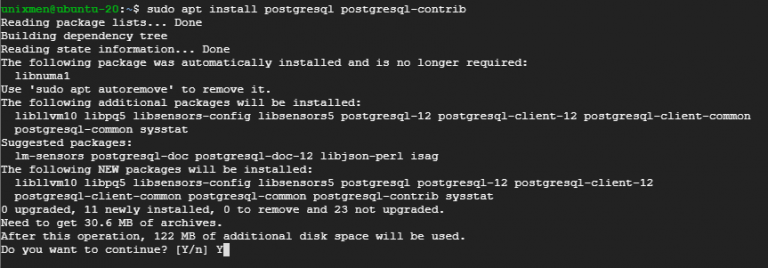
- #Ubuntu install postgresql how to
- #Ubuntu install postgresql install
- #Ubuntu install postgresql update
- #Ubuntu install postgresql password
Here is an example: Enter name of role to add: cleopatra While still being logged in as postgres run the following command to create a new user: createuser -interactive -pwpromptĪ prompt will be shown to you asking you to input your desired user role, name, password, and if you want the user to be a superuser. To create a new user, exit the Postgres shell by executing: \q In this step, you will be creating a new user that will be used to access your Postgres database remotely. You will be shown something similar to this: :~$ psql You can access the Postgres shell by running: psql The server user will be switched from root to postgres. When the process is complete, switch the user to postgres to be able to execute Postgres commands with Postgres default user by running: su - postgres
#Ubuntu install postgresql install
This will install Postgres along with its associated dependencies. When that is done, install Postgres by running: sudo apt-get install postgresql postgresql-contrib
#Ubuntu install postgresql update
Next, update your server packages and dependencies by running: sudo apt-get update
#Ubuntu install postgresql password
Then input your relevant user password or SSH key password if any. Server_ip is the IP address of your server Server_user is your server user you would like to log in with The first thing to do is SSH into your server by running: ssh _ip In this step, you will be installing Postgres on your server.
#Ubuntu install postgresql how to
In this article, we will be learning how to set up a remote Postgres database server to use for your projects. It is highly scalable and widely popular.

Postgres is a powerful relational database management system, it can handle large workloads from a single machine to that of a data center. Setting up a remote Postgres database server on Ubuntu 18.04 Since this is a fresh install of Ubuntu Server 20.04, before we install PostgreSQL 13, let’s update our system to the latest update.Michael Okoh Follow I code, that's all. If you’re usig root user remove sudo from each command on this tutorial. A non-root user with sudo privileges or a root user access.It can be A virtual machine locally using Virtualbox, VMWare workstation or VMWare Fusion, KVM, Xen, or a virtual machine in the cloud like DigitalOcean or Linode. A machine with fresh install of Ubuntu Server 20.04.This tutorial assume you already satisfy the following requirements: Administration Optimizations (vacuuming, replication slots).Major enhancements in PostgreSQL 13 includes: PostgreSQL 13 was released on 18 October 2018. PostgreSQL released under the terms of PostgreSQL license. It is developed by PostgreSQL Global Development Group (PGDG) that consists of many companies and individual contributors. PostgreSQL is ACID-compliant and transactional. PostgreSQL, or usually called Postgres, is an open-source object-relational database management system (ORDBMS) with an emphasis on extensibility and standards compliance.

In this tutorial, we learn how to install PostgreSQL 13 on Ubuntu 20.04 (Focal Fossa).


How To Install MongoDB 4.0 on Ubuntu 18.04.How To Enable Passwordless Sudo in Ubuntu.How To Install Virtualbox on Ubuntu 18.04.How To Install Virtualbox on Ubuntu 20.04.How To Install Amazon Corretto 8 on Ubuntu 18.04.How To Install Amazon Corretto 8 on Ubuntu 20.04.How To Install Amazon Corretto 16 on Ubuntu 20.04.How To Install Amazon Corretto 15 on Ubuntu 20.04.How To Install Amazon Corretto 16 on Ubuntu 18.04.How to Enable EPEL Repository on CentOS 8.Netlify deploy RangeError: Maximum call stack size exceeded.How To Install PostgreSQL 14 on Ubuntu 20.04.How To Install IntelliJ IDEA on Ubuntu 22.04 LTS.


 0 kommentar(er)
0 kommentar(er)
